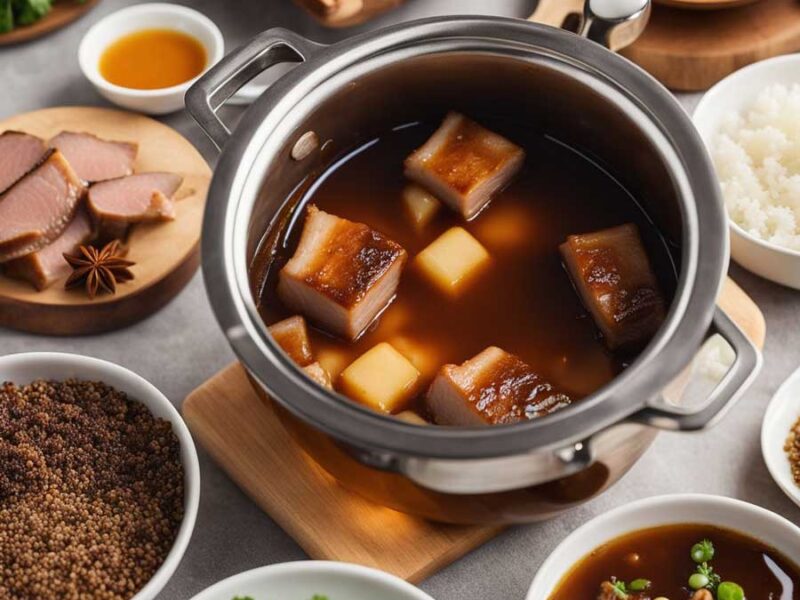We had the chance to sit down with Cathy Erway, the author of the recently released “The Food of Taiwan” at her apartment last Thursday. As we indulged in conversation about all things Taiwan, she made us her favorite Taiwanese dish: three cup chicken, or san bei ji—a flavorful, salty, and savory braised chicken dish with a hint of sweetness (her recipe here). Three cups, in this case, indicates the equal parts of soy sauce, sesame oil, and rice wine used in the dish. For more on the origins of Taiwanese cuisine, the word Q, and stinky tofu, read on!
Epoch Taste: Let’s talk about Taiwanese cuisine. What are some iconic Taiwanese dishes?
Cathy Erway: Beef noodle soup (niu rou mian) is a more recent favorite. Taiwanese three cup chicken (san be ji) has Haka influences. Dan zai noodle soup is a real great example of an old-fashioned, rustic kind of cuisine. And minced meat over rice (ru rou fan).
Epoch Taste: What are some of the influences that have made Taiwanese cuisine what it is today?
Cathy Erway: It’s a combination of the earlier settlers from Fujian, a very seafood-based cuisine that is more simple. And then there’s the Haka influence, which is all about offal, rough cuts, and dried seafoods, like dried squid, because they’re traditionally in mountainous terrains where they were pushed into less desirable areas for farming.
A big influence more recently is all the mainland arrival and immigrants at the end of the ’40s. With it, you get a whole mingling of mainland Chinese cuisines among themselves, as well as among the Taiwanese cuisines already here. For example, with the beef noodle soup, you see Sichuan influences and northern style noodles, which a lot of the times it’s this handmade shredded pulled noodle.
Epoch Taste: What about the indigenous cuisine?
Cathy Erway: I think that indigenous cuisine is seen in ingredients. They have these dragon beard ferns and these wild vegetables that are coveted nowadays by all kinds of Taiwanese. You see wild vegetables and cool herbs. There are some kind of more fun and rustic preparations for indigenous cuisines, like the bamboo sticky rice.
Epoch Taste: That is so true, there are so many vegetables that are native to Taiwan that you can’t find anywhere else in the world.
Cathy Erway: That’s what’s wonderful about it. Taiwan is such a place that is dependent on its terroir. You’re never going to get an exact replica over here in New York, but you can substitute with what is in season and awesome. Like strawberry in June instead of mango in your shaved ice! Shaved ice, that’s another hallmark.
Epoch Taste: Speaking of shaved ice, some toppings like mochi have been described as Q. Could you tell us more about Q?
Cathy Erway: This is a word that is describing a coveted texture. It’s hard to describe. It’s a little bit bouncy, a little bit firm, and not too soft. We wouldn’t call it “tender,” which is, I guess, one of the most coveted textures in Western cuisine. So it’s a little different. It’s fun. I definitely get the enjoyable nature of that texture. I heard this Taiwanese TV chef who tried to describe it as something like it bounces from your teeth, or bounces on the teeth.
Epoch Taste: What are some examples of Q foods?
Cathy Erway: Tapioca pearls is a good example. The skin of a ba wan (meatball mochi) is also a little jelly like.
Epoch Taste: What is stinky tofu and what do you do with it?
Cathy Erway: Stinky tofu is a type of fermented tofu dish that has a really pungent odor. You eat it [laughs].
Epoch Taste: It is my favorite. I love it. The smellier the better.
Cathy Erway: Right, there is something irresistible about stinky tofu. The stinkier the better, just kind of like cheese nerds would be all about that pungency and they can’t get enough of it so you build up this tolerance. Stinky tofu is very similar to cheese. Making tofu is very similar to cheese. You separate the curd, you strain it, you solidify it, and, finally, you age it. The flavor comes down to how long it’s been fermenting and what you put in the fermenting broth or brine.
Epoch Taste: What are some different ways stinky tofu is prepared?
Cathy Erway: How it’s prepared now is often fried as a street snack. You can also get blocks and make a stir fry with softer cubes. A really popular way nowadays is ma la stinky tofu. It’s in this braise and bath of really Sichuan-influenced fiery, chile oil.
Epoch Taste: Tell us about some of the people you learned cooking from in Taiwan.
Cathy Erway: I did a lot of dabbling around, but I think that there were a lot of people who helped me explore the best foods. These were friends of friends. When I was there first studying abroad for college, I would just piggy pack off of my friends and their parents. I got to go to their homes and see what their grandmas were making. I learned a lot from grandmas in general.
When I went back to travel for “The Food of Taiwan,” my photographer’s family, some aunts and uncles, were there so we would go to their houses and I would try to pick up anything I could learn from them. We randomly met some friends too who showed us around and let us get into some chef’s business and talk to them. It was kind of a motley crew, a total mix of people. People are so nice they would know someone who knew someone and it just escalated form there.
Epoch Taste: Of the recipes in the book, which would you recommend for time-pressed New Yorkers?
Cathy Erway: San bei ji, Haka stir fry, and most of the stir fries. Noodles can be quick if you make a lot of broth. Have a weekend project to make some broth and you can throw together quick noodle meals throughout the week. Bone broth is huge now, so just make some bone broth and mix in some veggies and noodles and what have you.
Epoch Taste: Finally, could you tell us your favorite Taiwanese dish?
Cathy Erway: I would say san bei ji. Honestly, it’s just my palate. I like the saltiness, I like the little bit of the sweetness, the little bit of spiciness. I guess I’m a fan of Haka flavors and basil.

